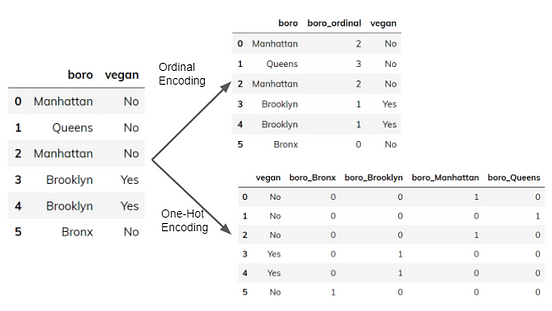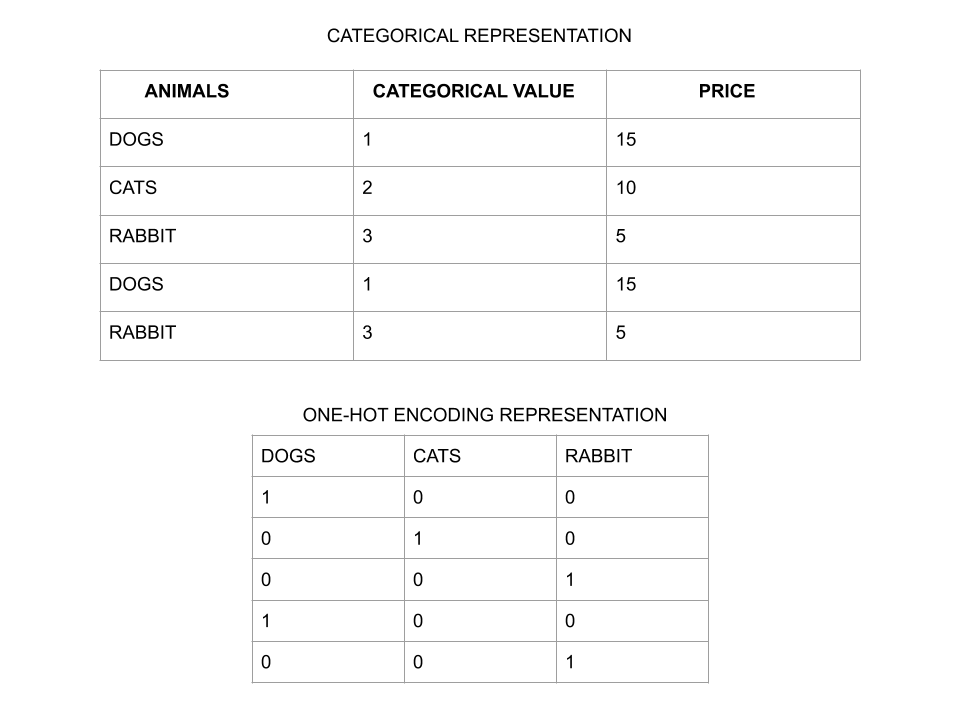43 label encoding vs one hot encoding
Label Encoding vs One Hot Encoding | by Hasan Ersan YAĞCI | Medium Label Encoding and One Hot Encoding 1 — Label Encoding Label encoding is mostly suitable for ordinal data. Because we give numbers to each unique value in the data. If we use label encoding in... The Difference between One Hot Encoding and LabelEncoder? There you go, you overcome the LabelEncoder problem, and you also get 4 feature columns instead of 8 unlike one hot encoding. This is the basic intuition behind Binary Encoder. **PS:** Give 2 power 11 is 2048 and you have 2000 categories for zipcodes, you can reduce your feature columns to 11 instead of 1999 in the case of one hot encoding! Share
Feature Engineering: Label Encoding & One-Hot Encoding - Fizzy The categorical data are often requires a certain transformation technique if we want to include them, namely Label Encoding and One-Hot Encoding. Label Encoding. What the Label Encoding does is transform text values to unique numeric representations. For example, 2 categorical columns "gender" and "city" were converted to numeric values, a ...

Label encoding vs one hot encoding
One-hot Encoding vs Label Encoding - Vinicius A. L. Souza The two most typical types of encodings are one-hot encoding or label encoding. On one-hot encoding, the column containing the categorical value is split into as many columns as categories, assigning either 0 or 1 to the column to represent the category. For the previous example, the one-hot encoding would be: France. Spain. Germany. Age. Salary. Muti-hot encoding vs Label-Encoding - Data Science Stack Exchange Binary encoding introduces false additive relationships between the categories (e.g. category 4 + category 1 = category 5 or 100 + 001 = 101) but fewer of them. Therefore, binary will usually work better than label encoding, however only one-hot encoding will usually preserve the full information in the data. Unless your algorithm (or computing ... Target Encoding Vs. One-hot Encoding with Simple Examples One-hot encoding is easier to conceptually understand. This type of encoding simply "produces one feature per category, each binary." Or for the example above, creating a new feature for cat, dog,...
Label encoding vs one hot encoding. label encoding vs one hot encoding | Data Science and Machine Learning ... In label encoding, we label the categorical values into numeric values by assigning each category to a number. Say, our categories are "pink" and "white" in label encoding we will be replacing 1 with pink and 0 with white. This will lead to a single numerically encoded column. Whereas in one-hot encoding, we end up with new columns. Comparing Label Encoding And One-Hot Encoding With Python Implementation The code snippet is shown below Here, by comparing the accuracy scores of the two encoder techniques, we can see that the accuracy score of the label encoder is less than the accuracy of the one-hot encoder. Outlook Most of the time, the outcome of a machine learning model is represented by how much accuracy rate the model is providing. Why One-Hot Encode Data in Machine Learning? Let's say I have a column of categorical data with 3 unique values like France, Germany, Spain. So after label encoding and one hot encoding, I get three additional columns that have a combination of 1s and 0s. I read somewhere in the Internet that just label encoding gives the algorithm an impression that the values in the column are related. Label Encoder vs. One Hot Encoder in Machine Learning To avoid this, we 'OneHotEncode' that column. What one hot encoding does is, it takes a column which has categorical data, which has been label encoded, and then splits the column into multiple columns. The numbers are replaced by 1s and 0s, depending on which column has what value. In our example, we'll get three new columns, one for ...
Label Encoder vs. One Hot Encoder in Machine Learning What one hot encoding does is, it takes a column which has categorical data, which has been label encoded, and then splits the column into multiple columns. The numbers are replaced by 1s and 0s,... Ordinal and One-Hot Encodings for Categorical Data Encoding Categorical Data There are three common approaches for converting ordinal and categorical variables to numerical values. They are: Ordinal Encoding One-Hot Encoding Dummy Variable Encoding Let's take a closer look at each in turn. Ordinal Encoding In ordinal encoding, each unique category value is assigned an integer value. Label Encoding vs. One Hot Encoding | Data Science and Machine ... - Kaggle One-Hot Encoding One-Hot Encoding transforms each categorical feature with n possible values into n binary features, with only one active. Most of the ML algorithms either learn a single weight for each feature or it computes distance between the samples. Algorithms like linear models (such as logistic regression) belongs to the first category. One Hot Encoding VS Label Encoding | by Prasant Kumar | Medium There we use Label Encoders for encoding because they replace them with labels that are comparable with each other. Taking the example of Satisfaction rating replacing "extremely dislike"- 0,...
Categorical Data Encoding with Sklearn LabelEncoder and OneHotEncoder Label Encoding vs One Hot Encoding. Label encoding may look intuitive to us humans but machine learning algorithms can misinterpret it by assuming they have an ordinal ranking. In the below example, Apple has an encoding of 1 and Brocolli has encoding 3. But it does not mean Brocolli is higher than Apple however it does misleads the ML algorithm. Label encoding vs Dummy variable/one hot encoding - correctness? Show activity on this post. I understand that when label encoding is used ,the numeric number can be interpreted to have an order and a model could assume a linear relationship. However shouldn't this be a problem when there are in-fact many levels in a categorical variable e.g. country. Categorical Encoding | One Hot Encoding vs Label Encoding The number of categorical features is less so one-hot encoding can be effectively applied. We apply Label Encoding when: The categorical feature is ordinal (like Jr. kg, Sr. kg, Primary school, high school) The number of categories is quite large as one-hot encoding can lead to high memory consumption. Choosing the right Encoding method-Label vs OneHot Encoder RMSE of One Hot Encoder is less than Label Encoder which means using One Hot encoder has given better accuracy as we know closer the RMSE to 0 better the accuracy, again don't be worried for such a large RMSE as I said this is just a sample data which has helped us to understand the impact of Label and OneHot encoder on our model.
When to Use One-Hot Encoding in Deep Learning? One hot encoding is a highly essential part of the feature engineering process in training for learning techniques. For example, we had our variables like colors and the labels were "red," "green," and "blue," we could encode each of these labels as a three-element binary vector as Red: [1, 0, 0], Green: [0, 1, 0], Blue: [0, 0, 1].
Encoding Categorical Variables: One-hot vs Dummy Encoding When to use one-hot encoding and dummy encoding Both types of encoding can be used to encode ordinal and nominal categorical variables. However, if you strictly want to keep the natural order of an ordinal categorical variable, you can use label encoding instead of the two types of encoding that we've discussed above.
What are the pros and cons of label encoding categorical ... - Quora LabelEncoder and OneHotEncoder are libraries in sklearn.preprocessing Package in PYTHON Label encoder is used for converting the categorical columns into the continous columns. So there is no particular Algorithm which works better with labelencoder. In PYTHON we have to neccesaraly convert categorical columns into continous data.
Difference between Label Encoding and One Hot Encoding Conclusion Use Label Encoding when you have ordinal features present in your data to get higher accuracy and also when there are too many categorical features present in your data because in such scenarios One Hot Encoding may perform poorly due to high memory consumption while creating the dummy variables.
Difference between Label Encoding and One-Hot Encoding | Pre-processing ... In one hot encoding, each label is converted to an attribute and the particular attribute is given values 0 (False) or 1 (True). For example, consider a gender column having values Male or M and Female or F. After one-hot encoding is converted into two separate attributes (columns) as Male and Female.
One hot encoding vs label encoding in Machine Learning Encoding is the action of converting. One-hot encoding converts the categorical data into numeric data by splitting the column into multiple columns. The numbers are replaced by 1s and 0s, depending on which column has what value. In our example, we'll get four new columns, one for each country — India, Australia, Russia, and America.
What exactly is multi-hot encoding and how is it different from one-hot ... Imagine your have five different classes e.g. ['cat', 'dog', 'fish', 'bird', 'ant']. If you would use one-hot-encoding you would represent the presence of 'dog' in a five-dimensional binary vector like [0,1,0,0,0]. If you would use multi-hot-encoding you would first label-encode your classes, thus having only a single number which represents ...
Label Encoder vs One Hot Encoder in Machine Learning [2022] One hot encoding takes a section which has categorical data, which has an existing label encoded and then divides the section into numerous sections. The volumes are rebuilt by 1s and 0s, counting on which section has what value. The one-hot encoder does not approve 1-D arrays. The input should always be a 2-D array.
When to use One Hot Encoding vs LabelEncoder vs DictVectorizor? Still there are algorithms like decision trees and random forests that can work with categorical variables just fine and LabelEncoder can be used to store values using less disk space. One-Hot-Encoding has the advantage that the result is binary rather than ordinal and that everything sits in an orthogonal vector space.








Post a Comment for "43 label encoding vs one hot encoding"